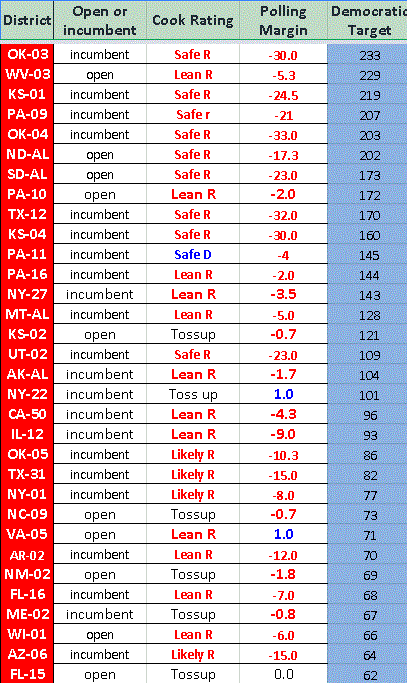Latest analysis of U.S. House prospects by Dan Guild. -promoted by desmoinesdem
In my last post here I wrote about the close seats that will decide who controls the House. I will get to that in a forthcoming post. For now, I want to focus on the possibility of a wave larger than people are expecting.
Right now most of the estimates are for the Democrats to win about 30 seats. Some estimates are higher (FiveThirtyEight has a median estimate of 38). My own estimate is for a Democratic gain of 30 seats, but with more close GOP-held seats in danger.
But two signs suggest that something bigger is in the offing. The first is shown in the table below. There has been a consistent gap between what the generic ballot polling is telling us and what district-level polling is telling us.
If you compare state polling with national polling in presidential elections, you find that the swing in the state polling is actually a better predictor of the final result than the national polling is. I discussed this phenomenon here shortly before the 2016 election.
The other data point–more compelling for considering a larger wave than people are expecting–is to look at the individual seats in play. In the UK, parties plan their strategy based on target lists. They take the other party’s seats and list them from the most likely to be vulnerable to the least likely.
I have performed that exercise for the U.S. House using a common measure of partisan performance (the PVI). The table below is a list of some of those seats and the current polling margin.
For example, let’s consider two seats on this list: the second Congressional districts of Kansas and Maine. KS-02 ranks 121st on the list of Democratic seats to target. Put another way, there are 121 other GOP seats that you would expect to find that are more vulnerable. Similarly, ME-02 ranks 67th on that list. And yet BOTH seats are close. In KS-02 the GOP leads by only 0.7 percent in polling. In ME-02 the Republican is 0.8 percent ahead.
These seats should not be close. That they ARE suggests other similar seats will be close as well. The problem is that we lack independent surveys of the races in those other seats. IF the polling is right in these two seats, one would expect 20 to 30 other seats to be close as well.
One of the best signs of a wave is races that should not be close, but are close. This list suggests that most predictions about the size of the Democratic victory may be far too small.
None of this analysis is certain. A 3-point shift in polling in the House is the difference between the Democrats taking 50 seats and falling short of the number they need to win. Nevertheless, the two signs I identified suggest that a wave is far more likely than a GOP surprise.



